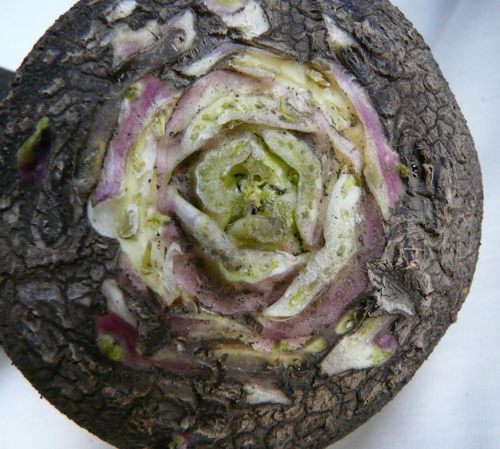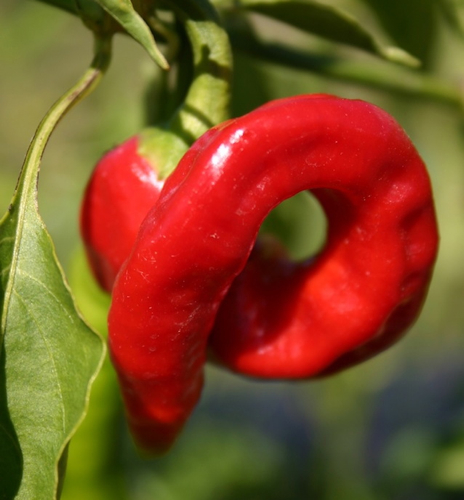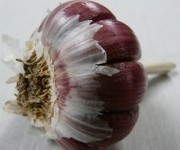 Ajo Rojo garlic.Photo: Anne Nester
Ajo Rojo garlic.Photo: Anne Nester
For those who like to get lost in the vast world of heirloom fruits and vegetables, the first National Heirloom Exposition, held mid-September in Santa Rosa, Calif., didn’t disappoint. The three-day event — which drew seasoned farmers, seed savers, edible educators, and backyard growers — included an exhibition hall filled with an impressive array of heirloom produce from farms and gardens around the country, including rare and exotic pumpkins, tomatoes, melons, and peppers. The expo also featured heritage farm animal breeds, chefs demos, expert speakers, heirloom food tastings, and a seed exchange.
For the innovators behind a soon-to-launch project called Pollin8r, it was the perfect place to get the word out. This two-pronged project will include both an open-access photo bank of heirloom produce, dubbed Food Foto Bank, and Pollin8r, an inventive new web-based project building on the Community Supported Agriculture (CSA) model, that promises to connect heirloom-produce loving eaters to farmers willing to grow heritage produce — all with just the click of a mouse.
 Black Spanish radish.Photo: Anne NesterWhy the push to protect heirloom produce? These plants predate industrial agriculture and are the result of open pollination, seed saving, and careful selection by farmers and backyard gardeners. Heirloom varieties are often suited to the climate or location where they are grown, though they can be trickier to grow than modern hybrid crops.
Black Spanish radish.Photo: Anne NesterWhy the push to protect heirloom produce? These plants predate industrial agriculture and are the result of open pollination, seed saving, and careful selection by farmers and backyard gardeners. Heirloom varieties are often suited to the climate or location where they are grown, though they can be trickier to grow than modern hybrid crops.
Still, heirloom fruits and vegetables have been making a comeback in certain food and farming circles, where they’re revered for their unique qualities and distinctive, complex flavors. And at a time when just five big biotech businesses control the global seed market through closed-pollination (which doesn’t allow for seed saving), trademarking, or both — this heirloom renaissance is a welcome addition to the food landscape.
In contrast, large-scale commercial farming has greatly diminished crop variety in order to maximize produce consistency, productivity, and its ability to withstand mechanical harvesting and cross-country transportation, as well as tolerance to drought, frost, and pesticides. Genetic diversity isn’t much considered, and flavor is often a secondary factor. Consider the average, supermarket tomato — devoid of taste but firm and long-lasting — as exhibit A in the argument to preserve the heirloom.
Heirloom produce meets Kickstarter meets CSA
Pollin8r co-founder Kyra Pincheira, a consultant to nonprofit organizations who is currently living on a farm in Boonsboro, Md., envisions Pollin8r as a potential win-win for consumers and farmers.
“I love seed catalogues and the idea of growing my own food,” says Pincheira, who worked for seven years as the director of learning for the environmental education nonprofit EarthEcho International. “But the reality is I have modest skills as a grower. There’s a long list of foods I like to eat that require a level of skill I don’t have. That’s where Pollin8r comes in.”
 Piel de Sapo melon.Photo: Anne NesterPinchiera views Pollin8r as a natural progression from the standard CSA, where consumers essentially buy into a farm by paying growers in advance for regularly scheduled boxes of seasonal fruits and vegetables. Only in a traditional CSA, farmers choose the crops.
Piel de Sapo melon.Photo: Anne NesterPinchiera views Pollin8r as a natural progression from the standard CSA, where consumers essentially buy into a farm by paying growers in advance for regularly scheduled boxes of seasonal fruits and vegetables. Only in a traditional CSA, farmers choose the crops.
While some farmers base some planting choices on consumer input, Pincheira says she hears from many who struggle with crop variety decisions. As she sees it, Pollin8r could take some of the guesswork out of the equation and offer new economic opportunities for farmers. It could also give customers a bigger say in the crops that their local farmers grow. And, like all CSAs, growers wouldn’t have to assume all the risk for planting crops.
If things go as planned, the site will allow farmers to notify local consumers about a brief period of time to pre-purchase “shares” so they could “pollinate” a crop, and in the Kickstarter manner of funding, a certain number of shares would need to be sold before a crop was sown. Farmers would then alert shareholders when a crop was ready for harvest. Pollin8r is also a way for eaters and growers to figure out what does well in their local communities. Consumers would be invested, though that investment, in monetary terms, would be a small one, around $15-20 per crop.
The team of 10 behind Pollin8r includes California farmer-educator Liz Snyder, photographer Anne Nester from Westminster, Maryland, and permaculturist Michael Judd from Frederick, Md. Gardener-web developer Jeff Aldrich in Buffalo, Minn., who grew up on a farm, co-founded the project with Pincheira, who will attend the upcoming Slow Money Third National Gathering in the hopes of securing financial and other support for the project.
 Jimmy Nardelo pepper.Photo: Mary Sue StevensPhoto bank
Jimmy Nardelo pepper.Photo: Mary Sue StevensPhoto bank
The Pollin8r site likely won’t be up and running until later this year. But in the meantime the group plans to launch the Food FotoBank later this month. The free online service offers gorgeous photos of heirloom and obscure crops from around the country, many taken at last month’s Heirloom Expo, where Pincheira and a crew of six snapped hundreds of images of antiquarian peppers, pumpkins, tomatoes, and other older varieties of fruits and vegetables to stock the start-up site.
Gardeners who grow heirloom produce will be able to add their own photos to the collection down the road. Judging by the interest at the expo, the site should find an audience. “We met farmers and gardeners looking for images for their websites, an author in need of photos for an upcoming book, teachers who need pictures to compliment classroom instruction, and a seed packet manufacturer who wants photos for his packets,” says Pincheira, who’s confident the photo library will whet the appetite of crop lovers around the country for Pollin8r.
Pincheira hopes both projects spark local community partnerships with farmer groups and heirloom enthusiasts. “Seventy-five percent of most people’s diet comes from eight staple crops, but there are literally tens of thousands of different varieties of fruits and vegetables to choose from,” she says. “This gives consumers more options to savor while it preserves the diversity of the food that ends up on our plate.”


